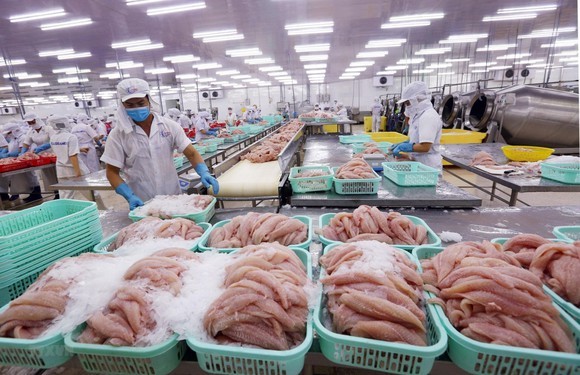 Illustrative image. (Photo: SGGP)
Illustrative image. (Photo: SGGP)
Speaking at the webinar to release the report, VASEP Vice President Nguyen Thi Thu Sac said that seafood is Vietnam's fifth biggest export product in terms of value, accounting for about 4 percent of the country’s export turnover. Vietnam's seafood exports in recent years have been valued at from US$8.5 billion to nearly $9 billion per year.
As the third largest seafood exporter in the world, in recent years, Vietnam has focused on sustainable development of the seafood industry. However, with the characteristics of small-scale fisheries, Vietnam is facing a big challenge related to the illegal, unreported and unregulated (IUU) fishing yellow card warning issued by the European Commission (EC) since October 2017.
The yellow card has caused Vietnam's seafood exports to the EU market to decline continuously from 2017 until now. From 2017-2019, its seafood export turnover to the markets of the European Union decreased by 12 percent, equivalent to $183.5 million.
Since 2019, the EU has dropped from the 2nd position to the 4th position among Vietnam’s seafood export markets, after the US, Japan and China.
Mona Sur, the WB’s Practice Manager for Environment, Natural Resources and Blue Economy for East Asia and the Pacific, stated that in order to have detailed assessments of these risks, VASEP collaborated with experts from Nha Trang University and Copenhagen Business University (Denmark) to implement the analysis, under the supervision of the World Bank.
Experts warn that if Vietnam has to receive a red card from the EC, the most immediate and direct impact on Vietnamese seafood will be the EC's trade ban. At that time, it is estimated that Vietnam's seafood industry will lose about $480 million each year if it loses the EU market.
If Vietnam soon has the yellow card removed, and takes advantage of tariff preferences and changes of institutions from the EVFTA, the opportunity to recover and increase seafood exports to the EU market to $1.2 billion-$1.4 billion in the coming years is feasible.
This shows that it is necessary to have reasonable and effective solutions to make the EC soon remove the yellow card, and achieve 7-9 percent in seafood exports and $16 billion-$18 billion in total export turnover by 2030.
As the third largest seafood exporter in the world, in recent years, Vietnam has focused on sustainable development of the seafood industry. However, with the characteristics of small-scale fisheries, Vietnam is facing a big challenge related to the illegal, unreported and unregulated (IUU) fishing yellow card warning issued by the European Commission (EC) since October 2017.
The yellow card has caused Vietnam's seafood exports to the EU market to decline continuously from 2017 until now. From 2017-2019, its seafood export turnover to the markets of the European Union decreased by 12 percent, equivalent to $183.5 million.
Since 2019, the EU has dropped from the 2nd position to the 4th position among Vietnam’s seafood export markets, after the US, Japan and China.
Mona Sur, the WB’s Practice Manager for Environment, Natural Resources and Blue Economy for East Asia and the Pacific, stated that in order to have detailed assessments of these risks, VASEP collaborated with experts from Nha Trang University and Copenhagen Business University (Denmark) to implement the analysis, under the supervision of the World Bank.
Experts warn that if Vietnam has to receive a red card from the EC, the most immediate and direct impact on Vietnamese seafood will be the EC's trade ban. At that time, it is estimated that Vietnam's seafood industry will lose about $480 million each year if it loses the EU market.
If Vietnam soon has the yellow card removed, and takes advantage of tariff preferences and changes of institutions from the EVFTA, the opportunity to recover and increase seafood exports to the EU market to $1.2 billion-$1.4 billion in the coming years is feasible.
This shows that it is necessary to have reasonable and effective solutions to make the EC soon remove the yellow card, and achieve 7-9 percent in seafood exports and $16 billion-$18 billion in total export turnover by 2030.
























